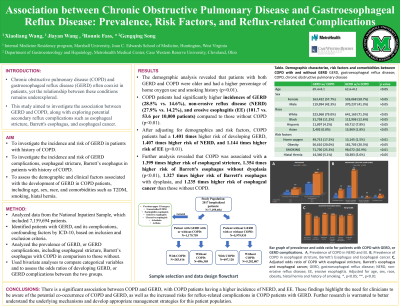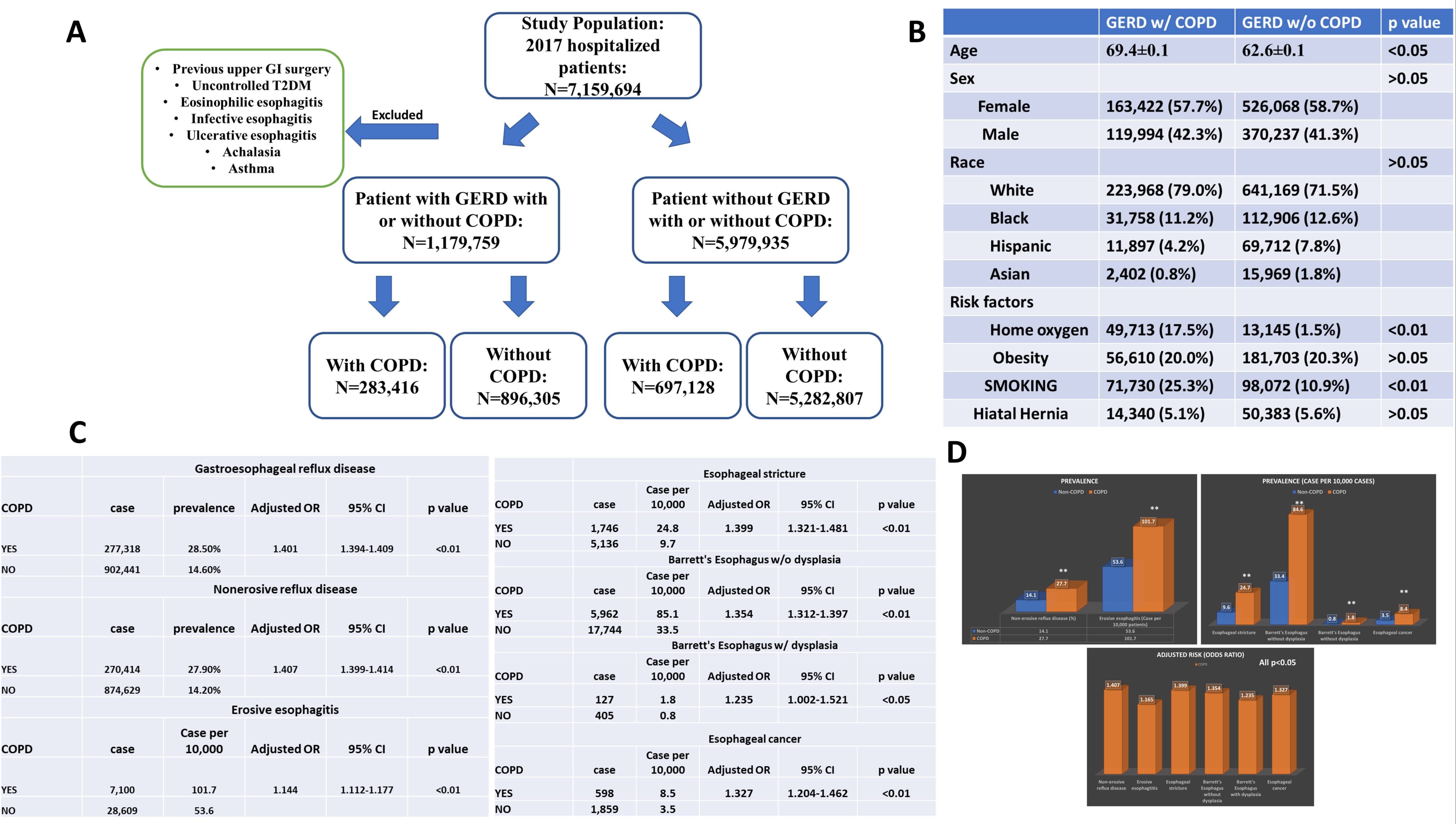Tuesday Poster Session
Category: Esophagus
P3249 - Association Between Chronic Obstructive Pulmonary Disease and Gastroesophageal Reflux Disease: Prevalence, Risk Factors, and Reflux-Related Complications
Tuesday, October 24, 2023
10:30 AM - 4:00 PM PT
Location: Exhibit Hall

Has Audio
.jpeg.jpg)
Xiaoliang Wang, MD, PhD
Marshall University School of Medicine
Huntington, WV
Presenting Author(s)
Xiaoliang Wang, MD, PhD1, Jiayan Wang, MD, PhD1, Ronnie Fass, MD2, Gengqing Song, MD2
1Marshall University School of Medicine, Huntington, WV; 2MetroHealth Medical Center, Case Western Reserve University, Cleveland, OH
Introduction: Chronic obstructive pulmonary disease (COPD) and gastroesophageal reflux disease (GERD) often coexist in patients, yet the relationship between these conditions remains underexplored. This study aimed to investigate the association between GERD and COPD, along with evaluating potential secondary reflux complications such as esophageal stricture, Barrett's esophagus, and esophageal cancer.
Methods: A population-based analysis was conducted on 7,159,694 patients to examine the association between GERD and COPD. Patients diagnosed with GERD, both with and without COPD, were compared to individuals without GERD. The inclusion criteria for COPD encompassed centrilobular and panlobular emphysema, as well as chronic bronchitis. Demographic factors, risk factors associated with COPD and GERD, and home oxygen use were considered to mitigate confounding factors. Bivariate analyses were performed using appropriate statistical tests such as the chi-squared test or Fisher's exact test (2-tailed) for categorical variables, to assess group differences.
Results: The demographic analysis revealed that patients with both GERD and COPD were older (69.4 VS 62.6) and had a higher percentage of home oxygen use (17.5% VS 1.5%) and smoking history (25.3% VS 10.9%) (p< 0.01). Surprisingly, COPD patients had significantly higher incidences of GERD (28.5% vs. 14.6%), non-erosive reflux disease (NERD) (27.9% vs. 14.2%), and erosive esophagitis (EE) (101.7 vs. 53.6 per 10,000 patients) compared to those without COPD (p< 0.01). After adjusting for demographics and risk factors, COPD patients had a 1.401 times higher risk of developing GERD, 1.407 times higher risk of NERD, and 1.144 times higher risk of EE (p< 0.01). Further analysis revealed that COPD was associated with a 1.399 times higher risk of esophageal stricture, 1.354 times higher risk of Barrett's esophagus without dysplasia (p< 0.01), 1.327 times higher risk of Barrett's esophagus with dysplasia, and 1.235 times higher risk of esophageal cancer than those without COPD.
Discussion: There is a significant association between COPD and GERD, with COPD patients having a higher incidence of GERD, NERD, and EE. These findings highlight the need for clinicians to be aware of the potential co-occurrence of COPD and GERD, as well as the increased risks for reflux-related complications in COPD patients with GERD. Further research is warranted to better understand the underlying mechanisms and develop appropriate management strategies for this patient population.

Disclosures:
Xiaoliang Wang, MD, PhD1, Jiayan Wang, MD, PhD1, Ronnie Fass, MD2, Gengqing Song, MD2. P3249 - Association Between Chronic Obstructive Pulmonary Disease and Gastroesophageal Reflux Disease: Prevalence, Risk Factors, and Reflux-Related Complications, ACG 2023 Annual Scientific Meeting Abstracts. Vancouver, BC, Canada: American College of Gastroenterology.
1Marshall University School of Medicine, Huntington, WV; 2MetroHealth Medical Center, Case Western Reserve University, Cleveland, OH
Introduction: Chronic obstructive pulmonary disease (COPD) and gastroesophageal reflux disease (GERD) often coexist in patients, yet the relationship between these conditions remains underexplored. This study aimed to investigate the association between GERD and COPD, along with evaluating potential secondary reflux complications such as esophageal stricture, Barrett's esophagus, and esophageal cancer.
Methods: A population-based analysis was conducted on 7,159,694 patients to examine the association between GERD and COPD. Patients diagnosed with GERD, both with and without COPD, were compared to individuals without GERD. The inclusion criteria for COPD encompassed centrilobular and panlobular emphysema, as well as chronic bronchitis. Demographic factors, risk factors associated with COPD and GERD, and home oxygen use were considered to mitigate confounding factors. Bivariate analyses were performed using appropriate statistical tests such as the chi-squared test or Fisher's exact test (2-tailed) for categorical variables, to assess group differences.
Results: The demographic analysis revealed that patients with both GERD and COPD were older (69.4 VS 62.6) and had a higher percentage of home oxygen use (17.5% VS 1.5%) and smoking history (25.3% VS 10.9%) (p< 0.01). Surprisingly, COPD patients had significantly higher incidences of GERD (28.5% vs. 14.6%), non-erosive reflux disease (NERD) (27.9% vs. 14.2%), and erosive esophagitis (EE) (101.7 vs. 53.6 per 10,000 patients) compared to those without COPD (p< 0.01). After adjusting for demographics and risk factors, COPD patients had a 1.401 times higher risk of developing GERD, 1.407 times higher risk of NERD, and 1.144 times higher risk of EE (p< 0.01). Further analysis revealed that COPD was associated with a 1.399 times higher risk of esophageal stricture, 1.354 times higher risk of Barrett's esophagus without dysplasia (p< 0.01), 1.327 times higher risk of Barrett's esophagus with dysplasia, and 1.235 times higher risk of esophageal cancer than those without COPD.
Discussion: There is a significant association between COPD and GERD, with COPD patients having a higher incidence of GERD, NERD, and EE. These findings highlight the need for clinicians to be aware of the potential co-occurrence of COPD and GERD, as well as the increased risks for reflux-related complications in COPD patients with GERD. Further research is warranted to better understand the underlying mechanisms and develop appropriate management strategies for this patient population.

Figure: Figure A, study design and sample selection flowchart. B, Demographic characterize, risk factors and comorbidities between COPD with and without GERD. C, Prevalence and odds ratio of GERD and GERD complication in patients with COPD. D, Bar graph of prevalence and odds ratio of GERD and GERD Complications in patients with COPD. GERD, gastroesophageal reflux disease; COPD, chronic obstructive pulmonary disease; *, p<0.05; **, p<0.01
Disclosures:
Xiaoliang Wang indicated no relevant financial relationships.
Jiayan Wang indicated no relevant financial relationships.
Ronnie Fass indicated no relevant financial relationships.
Gengqing Song indicated no relevant financial relationships.
Xiaoliang Wang, MD, PhD1, Jiayan Wang, MD, PhD1, Ronnie Fass, MD2, Gengqing Song, MD2. P3249 - Association Between Chronic Obstructive Pulmonary Disease and Gastroesophageal Reflux Disease: Prevalence, Risk Factors, and Reflux-Related Complications, ACG 2023 Annual Scientific Meeting Abstracts. Vancouver, BC, Canada: American College of Gastroenterology.
